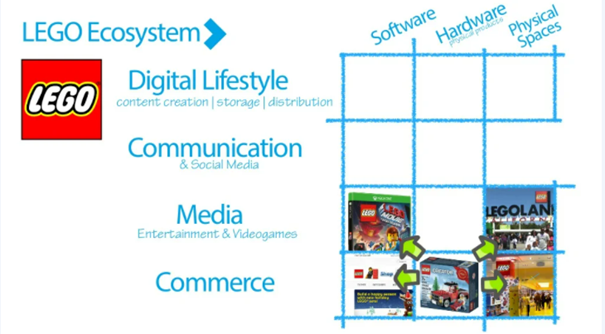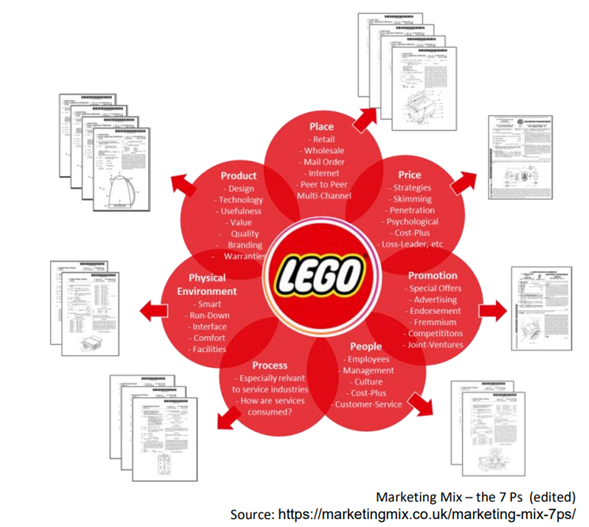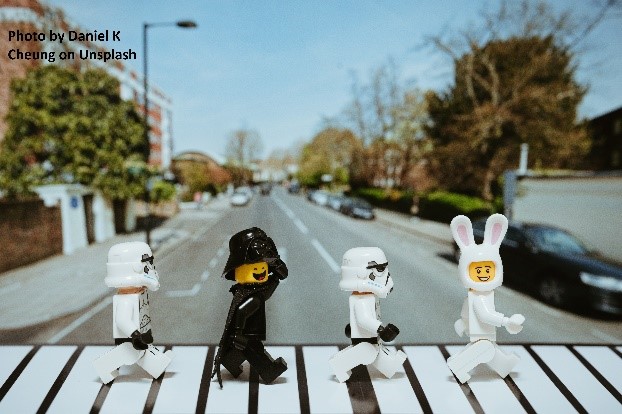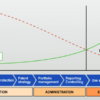Did they really patent this use case? – The Lego eco-system
The LEGO group is a Danish toy company, which was founded in 1932 by Ole Kirk Christiansen. He was a carpenter who initially started with the production of wooden toys for children, but introduced in 1947 the now famous plastic bricks. In 2015 the Group became the world’s biggest toy manufacturer by revenue. But times were not always that good for LEGO. Around the year 2000, the brand struggled with saturated markets and after the expiry of the LEGO brick patent in 1988 with the move away from the core market of selling bricks into many directions mostly in the digital space. This did not proof successful initially and in 2003 Lego developed a new business strategy. They first stabilized the core business of selling bricks and then slowly but steadily expand their eco-system to adjacent business areas based on a clear brand strategy. And they are still doing it today, e.g. in their cooperation with Epic Games to create a save playground in the metaverse. How they did this can be read in the LEGO case study 2014 and the resulting consequences for their IP strategy were presented by the MIPLM students below.
Customer journey and eco-system design of LEGO
Over the years, LEGO established a clear and consistent customer experience with the whole LEGO eco-system while expanding their business from selling bricks to many adjacent areas. Forrester defines customer experience as: “Customer experience is how customers perceive their interactions with your company.” Here, interaction is a two-sided process, where one side is the communication of a brand promise and the other side is the fulfillment of the brand promise. Or in other words a company communicates a brand image and sets certain expectations and then has to deliver the actual value and meet the expectations to create a customer experience which is perceived as useful, usable and joyful.
A concept related to the customer experience is the customer journey. A customer journey is a representation of the service process from the customer perspective over time. The customer journey is often split into a series of customer touchpoints. The customer touchpoints are defined as the points of customer interaction or communication with the product or service offering company. The whole concept of the customer journey works as a tool to analyze the customer experience along the customer touchpoints and to model the effects of the individual touchpoints. The different customer journeys with LEGO can be differentiated based on the different segments of the eco-system, seen in the next picture:

Source: Ecosystem Design (slideshare.net)
The customer journeys can be separated in two ways, either by the object of interaction, a digital customer journey via software, a physical customer journey with a LEGO product or with a physical location, such as a shop or an amusement park. In a similar way it can be distinguished, if it is based on a shopping experience or entertainment, either by watching or playing with digital media or in a physical park.
Intellectual property and the marketing mix
The marketing mix concept is one of the most successful and powerful management concepts ever developed for executives. Since the 1960s, it has been one of the essential organizing themes for marketing campaigns. The marketing mix refers to the set of actions, or tactics, that a company uses to promote its brand or product in the market. The 4Ps make up a typical marketing mix – Price, Product, Promotion and Place.
The 4Ps (Product, Promotion, Price, Place) were designed at a time where businesses were more likely to sell products, rather than services and the role of customer service in helping brand development was not so well known. Over time, Booms and Pitner added three extended “service mix Ps”: Participants, Physical evidence and Processes, and later Participants was renamed People (see next Figure). The 7Ps concept is in general used in the service industries – and within the internet-based digitalization, nearly every business becomes predominantly a service.
The marketing mix and the 7Ps can be applied to analyze the interactions of the customers with the LEGO eco-system. Those interactions which create positive customer experiences are ideally protected with IP to make the interaction with the customer in that specific use case unique.

Questions:
1. Please describe the new business strategy of Lego since 2003 and the consequences for the IP strategy based on the LEGO case study.
2. Please describe the customer journey with LEGO in a typical use case within the LEGO eco-system including all relevant customer touchpoints. Please focus on the following business area of LEGO:
-
- Group 1: Core business: LEGO theme sets
- Group 2: Active digital entertainment: LEGO Video games
- Group 3: Passive digital entertainment: LEGO movies
- Group 4: Physical entertainment: LEGOLAND
- Group 5: Physical retail: LEGO stores
3. Please identify IP rights from the LEGO portfolio which protect the relevant segments of the 7P marketing mix in the chosen use case.
Group 1: Terita Kalloo, Timofey Rubchenko, Branimir Puškarić, Merve Şimşek, Peter Conlon
Cannot open the video? Please click: https://youtu.be/cOODUs9QAAU
Group 2: Andreas Werner, Anders Isaksson, Sinara Travisani Cardozo, Veronique Bolinches, Sachin Seshadri
Cannot open the video? Please click: https://youtu.be/Gne0zf3b6ew
Group 3: Anita Yaryna, Felipe Bustos, Johannes Holzmair, Andrea Foglia, Clement Lim, Steffen Rutter
Cannot open the video? Please click: https://youtu.be/dpcals9OvBw
Group 4: Claire Laurens de Lopez, Yanan Huang, Konstantinos Kontogiannis, Rita Labundy, Ricardo Cali
Cannot open the video? Please click: https://youtu.be/WsPMr1uQ5Mw
Group 5: Greta Zekiene, Nina Šlat, Nora Rüter, Shu-Pei Oei, Maria Boicova-Wynants
Cannot open the video? Please click: https://youtu.be/V39ZVvr1WaE
Cannot open the video? Please click: https://youtu.be/2p7yChhy92s



